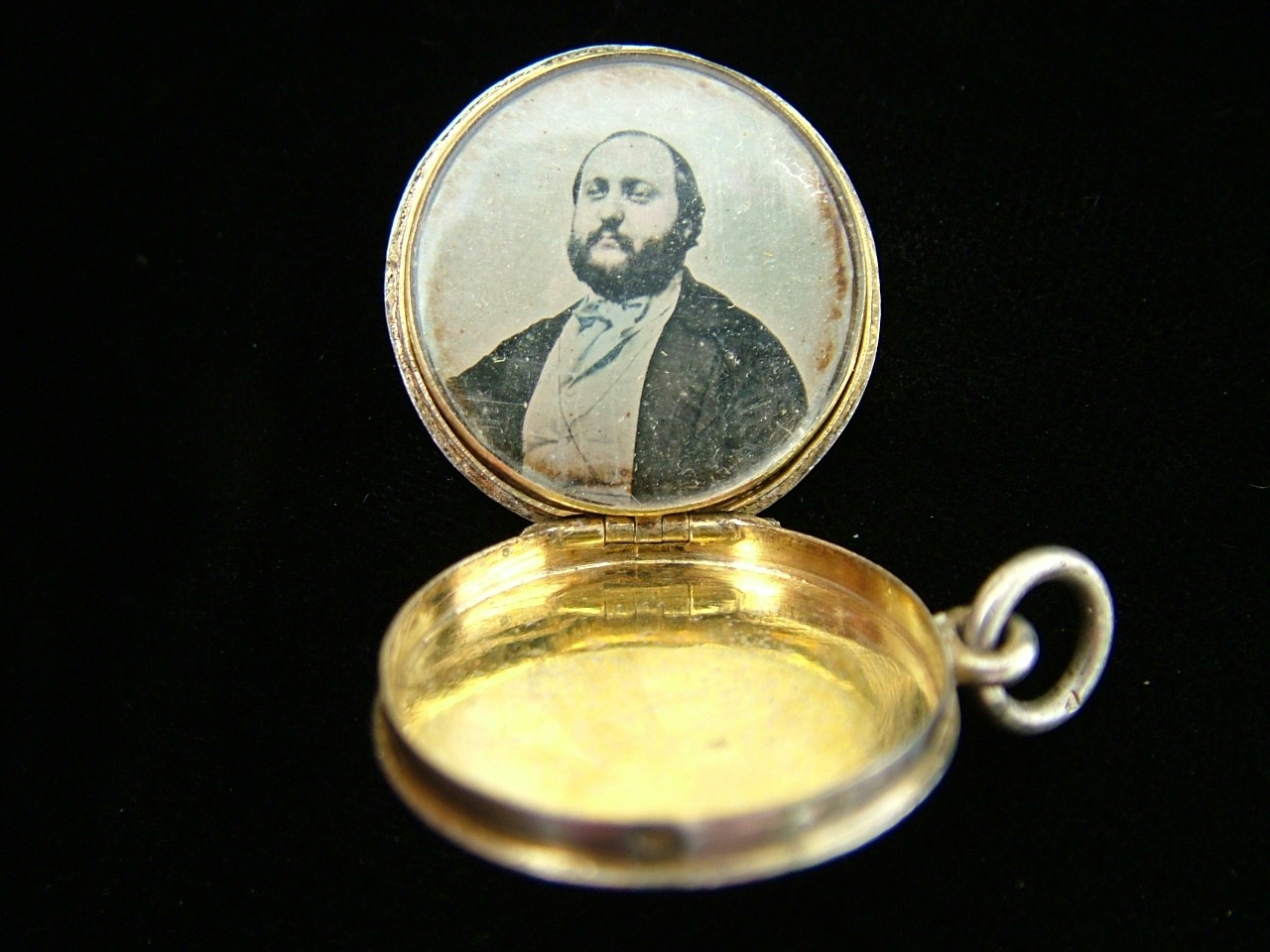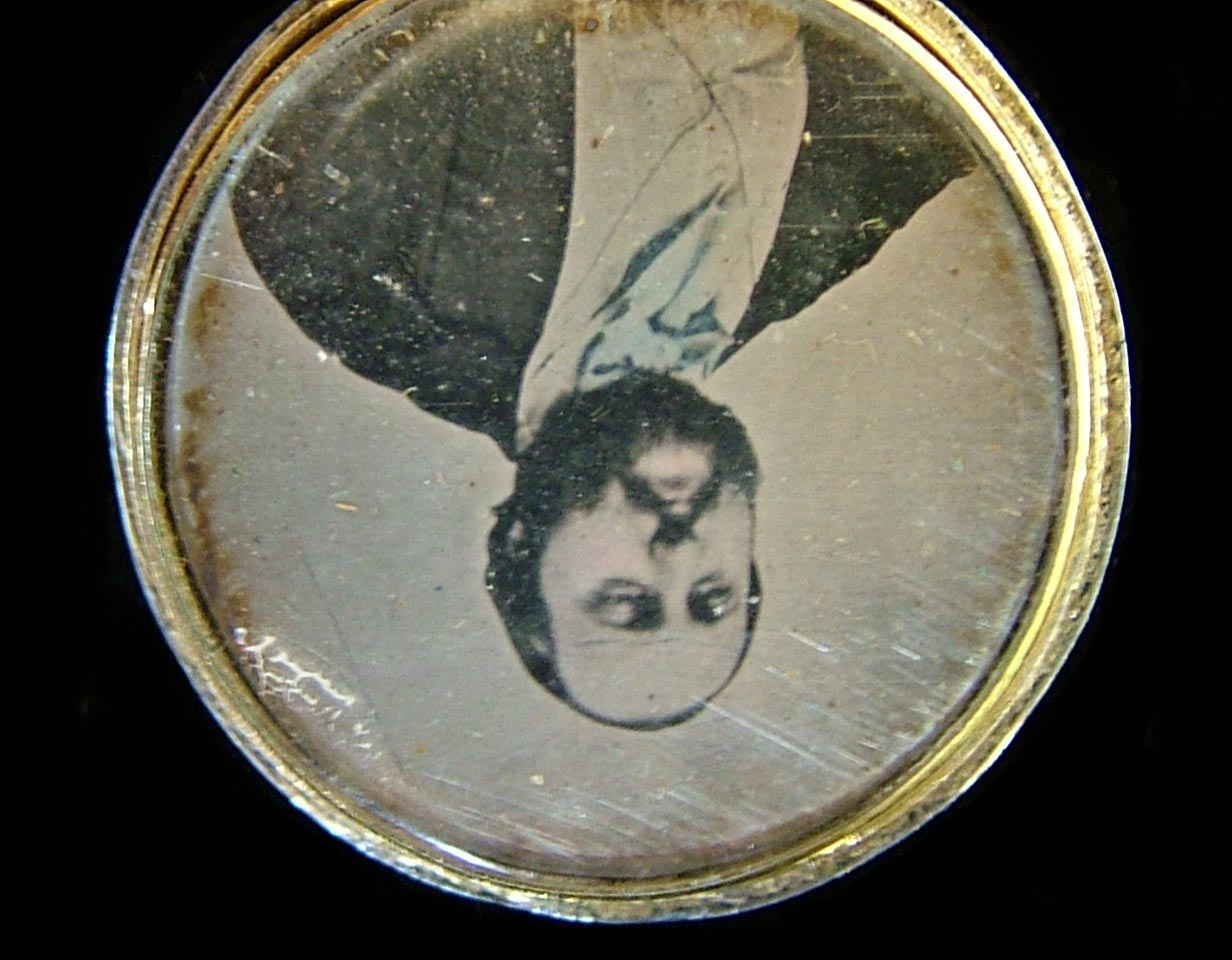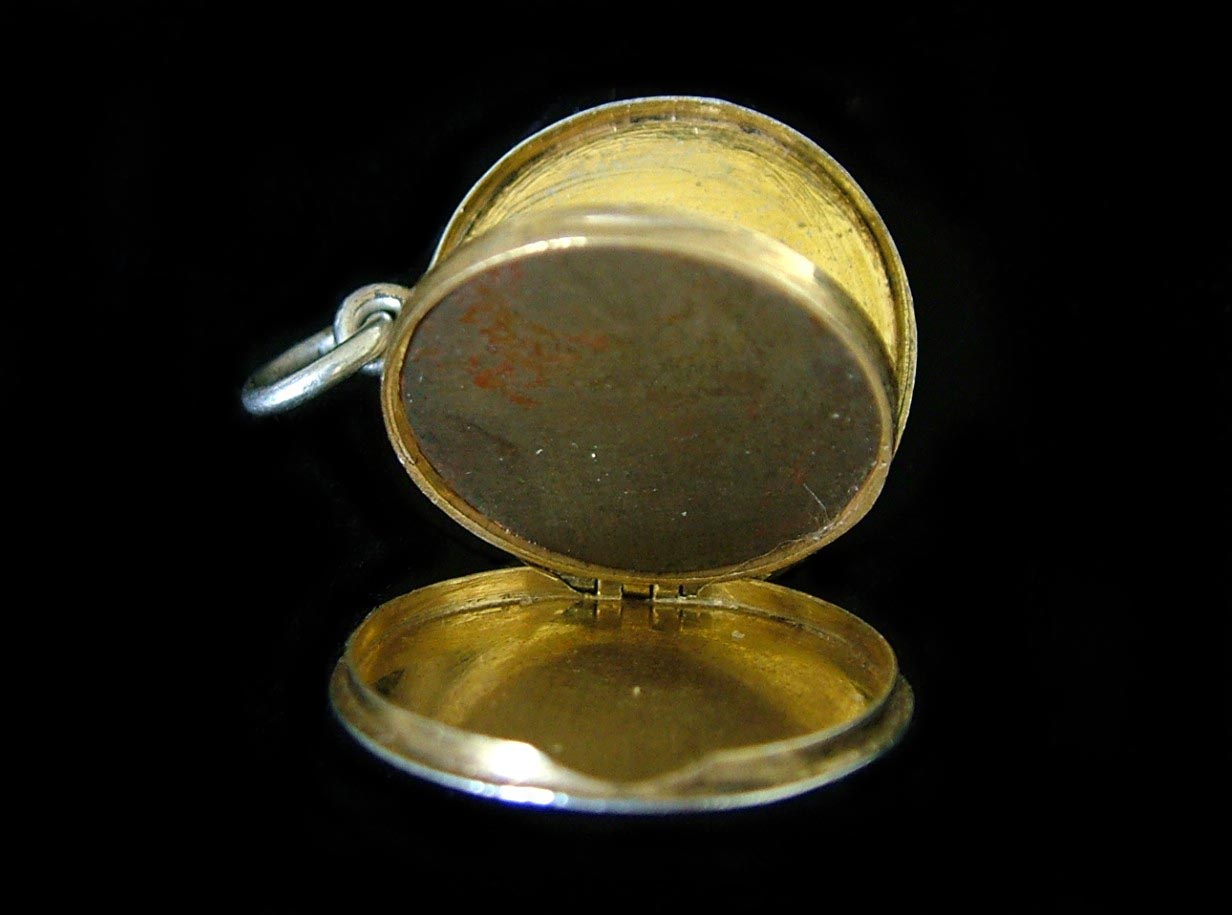 |
|---|
HIGHLY IMPORTANT NAPOLEONIC LOCKET WITH DAGUERREOTYPE OF JOSEPH BONAPARTE, C. 1840 TO 1844 |
|
PICTURE/INFO. REVISIONS WITH THIS ARTIFACT ARE A WORK IN PROGRESS This is a fourth generation owned antique. I acquired it from a California collector who had purchased it from a museum in San Francisco. It had been donated to the museum in the late 19th Century as an artifact owned by Louis H. Mailliard and, or his wife Angelic by a relative of Mailliard. Mailliard was the first secretary, confidant, and special agent to Joseph Napoleon Bonaparte (1768 to 1844), King of Naples (1806 to 1808), King of Spain (1808 to 1813), and Emperor of the French as the Bonapartist pretender (1832 to 1844). In 1817 after Mailliard had successfully returned from a secret mission J. Bonaparte wrote among other praises that he considered Mailliard his right hand. The secret mission was that Mailliard had orchestrated and carried out the hiding, recovery, and return of J. Bonaparte's treasure. It is a gold plated silver locket which contains encased in glass a daguerreotype of J. Bonaparte. Including the necklace ring, the locket is 3 cm in length. The entire locket including the glass has miniature art and inscriptions on it, most notable are two references to the legend of the Jersey Devil, a reference to J. Bonaparte's treasure, a possible reference to Lord Cochrane, and a possible reference to Napoleon's gold.* It is the only photo image known of Jospeh Bonaparte and one of only a few photo images of the of the original Imperial House of Bonaparte, it is the only daguerreotype. The only other examples are a handful of extremely rare ambrotypes or parlor card images of Jerome Bonaparte (1784 to 1860, Napoleon's youngest brother). At the time this daguerreotype was taken Joseph Bonaparte was the pretender to the French Imperial throne. The locket, the glass, and the back of the daguerreotype have miniature art and inscriptions. Most prominent are those of the famed legend of the Jersey Devil. With the locket there were also three other jewelry artifacts from the same group. The group has importance relating to the history of the following countries; America, Chile, England, France, Haiti, Mexico, and all of South America. Due to the historical importance of the miniature art/inscriptions on these they were given titles, they are the following three jewelry pieces: THE MINA GAUDALOPE: It is a 20 to 23 K gold Our Lady of Guadeloupe pendant of a Mexican Indian Guadeloupe with a Spanish Guadeloupe's crown, it is 3 cm in length. The pendant appears to had been a "gift" from General Francis Xavier Mina (Sp. Francisco Javier Mina) to Joseph Bonaparte and may have even symbolized the alleged promise by Mina of the Mexican Imperial crown. Among many other things it has symbolic iconography of the three initial ships of the Mina Expedition; the schooner's Caladonia and Calypso, and the Brig the Dolphin. THE LORD COCHRANE NAPOLEON. It is a 14 K gold, silver, and niello pendant of Napoleon I, it is 2.8 cm in length. The miniature art/inscriptions on it are of a never realized expedition to rescue Napoleon from St. Helena to Haiti and then South America to be led by Admiral Lord Thomas Cochrane, 10th Earl of Dundonald. The pendant appears to have been a "gift" from Cochrane or Lord Holland (that likely was delivered by an agent) to Joseph Bonaparte, but yet it also "may" have been a "gift" from Paulina Bonaparte. NAPOLEON'S IRON FIST. It is a 9 to 10 K gold watch key holder, it is 2.1 cm in length The theme with the miniature art/inscriptions is once again of Napoleon's planned rescue from St. Helena. If you would like to view pictures and more information on the Mina Guadeloupe, the Lord Cochran Napoleon, and Napoleon's Iron Fist go here and scroll down : Click Here. * The Jersey Devil (aka JD) is the most popular legend in New Jersey, enough so that in 1938 the state of New Jersey officially declared it the state's demon, it is the only state demon in America. There are many versions of the legend, but summarizing the most popular version; A woman named Mother Leeds (who in some versions was a witch married to the devil) was frustrated after having 12 children, so when pregnant with her 13th she cursed the child as to give it to the devil, or to be a devil. The child was born normal (or some say misshapen) on a stormy night in 1735, at some point the child turned into a demon, then flew out the chimney to inhabit the vast Pine Barrens of southern New Jersey. There are various descriptions of JD but the most popular version states that it has a horse-like head, bird or hoofed feet, bat-type wings, and a tail. There have been many alleged sightings over the years by various people of different stations, but the two most famous are Commodore Stephen Decatur and Joseph Bonaparte. It is claimed that J. Bonaparte had an encounter with JD while hunting near his estate as Point Breeze, NJ. According to an inscription on the back of the daguerreotype the year was 1820. As several other artifacts including this one suggests that J. Bonaparte had been involved in espionage at that time to free his younger brother Napoleon from captivity on St. Helena, then there are hints that the story of his sighting of JD "may" have also had (or just plain had) something to do with the famed Scotsman Lord Cochrane aka "Cochrane the Devil" who was rumored by his wife to be planning to rescue Napoleon from St. Helena C. 1820 (Napoleon died in 1821). If so then this may or may not have had something to do with Decatur's sighting of the JD and sending a message to any Bonapartists in the Western hemisphere. This speculation does entirely not rule out that J. Bonaparte may have had an encounter with "something' unknown in 1820, but that he may have decided that it was also a convince with his espionage activities. Do I believe that there is any such thing as the JD as usually described, no! Do I believe that it is possible that "something" has transpired over the years in the Pine Barrens that may have a scientific explanation (that we may or may not be able to fully understand), yes! To my knowledge the two depictions seen on this artifact (C. 1840 to 1844) are the earliest known representations of the JD. So far my research shows that the next image known is a rather famed illustration from an eye witness account in the Philadelphia Evening Bulletin in 1909. More info. with this artifact is that there is also suggestion of Paulina Bonaparte (the youngest of the original Imperial Bonaparte's) as a secret agent in Rome, J. Bonaparte's treasure, J. Bonaparte's summer estate in NY at Lake Diana (now known as Lake Bonaparte), and possibly Napoleon's gold.
Copyright 2007 David Xavier Kenney Revised Feb 2011 The locket daguerreotype of Joseph Bonaparte was further authenticated in 2009 by a a photograph expert in London for a major auction house. For further information contact Dave Kenney at: Tele: 786.276.7245 |
|
|
|
|
| JOSEPH BONAPARTE AND THE JERSEY DEVIL
|
|
| This shows the daguerreotype when placed upside down. It is an image of the birth of Jersey Devil and the Devil's face during a hail or snow storm under a woman that appears to be the goddess Artemis/Diana, she is holding a moon, crystal ball, or pearl (when seen closer the moon changes into figures). Most of the work was done with carving outside and inside of the glass, specks of paste and tints over the face on the inside of the glass, but not the daguerreotype itself.* To the right there is work done in lead (or perhaps lead and mercury), it is of lighting, Native American petroglyphs, and perhaps other subjects. The goddess has many figures in her hair, her hair is also as a cape of a lizard or a dragon, the lizard or dragon's head can be seen to the right. This suggests that among other things that she is an Amazon goddess that most likely is associated with Mother Leeds of the JD legend. When the area of her face is seen closer it shows a standing figure in a foggy circular clearing, there are other figures around this. The devil's face has a widow's peak hair, two horns, long side burns, a hint of a very short beard, and then four demonic eyes (over and under) and facial stretching (in that the bottom lip is over the nose). There may or may not be a hint of a smoke stack between the eyes, but either way there is work showing figures in white on white. The face is very much like a mask, this along with the four eyes suggests the masked spirit Mesingw aka Mesinghalikun ((Living Solid Face) of the Leni Lenape tribe (of the Delaware Indians). Mesingw was a guardian of the forest and game animals. Some have speculated that Mesingw was responsible for some aspects of the JD legend. The lighting as petroglyphs appear to be of some Native American spirit associated with a fish, a beaver, and corn. * I know about this type of 19th C. engraved miniature art work on glass as I have studied similar work on plate glass that is in a frame over a drawing by Degas done in the early 1880's, it appears that the drawing, glass, and frame had been Degas's fetish piece at that time, or perhaps one of his fetish pieces. I expect that this technique "may" have only been used by artists and, or craftsmen from the mid to late 19th C. |
|
|
|
|
| THE JERSEY DEVIL AT POINT BREEZE / THE PINE BARRENS
|
|
| This will be shown and explained later but there is musical movement associated with the Jersey Devil seen here, it is Haydn's Symphony No.73 "La Chasse" ("The Hunt"). The back of the daguerreotype has engraved and tint work on the copper with some paint over it. The engraving and tinting appears to have been done prior to the image on the daguerreotype being taken, so the copper plate used for the daguerreotype may have originated from something else, if so then there are hints with a few other bits of miniature art and inscriptions that suggest something to do with Goya. For the most part most of the images seen on the back can only be seen at an angle, thus it is disguised to appear as residue from glue from something that had been stuck on to the back and then removed. Most of the art is figurative but yet is also abstract, there are bind letters mixed in with the art.* The image shows a large head with a crown with a large globe with figures in it facing in profile to the right. The crown is also has a type of sled facing to the left with many figures. Under the crown are the bind letters "JB", "JD", and "BP", but also "TC" and "TRES". These should read "Joseph Bonaparte", "Jersey Devil", "Point Breeze" but also "Pine Barrens", then possibly "Thomas Cochrane" and "Tresor" (Fr. for Treasure). The bind letters "PB" also shows a figure with a dragonesque head holding a tail with a point facing to the left, the tail's point is on or part of the eye of the large head in profile, behind this are folded bird or bat wings. There are many smaller figures that are inside this large figure. All this will transform when placed in the other three directions. This is the Jersey Devil at Point Breeze / Pine Barrens, but there is more and shortly there will be additional picture groups with explanations or speculations. *After studying countless artifacts I can comfortably state that bind letters were used extensively in ancient times, but none so much as with anything associated with the Roman Legions, this tradition continued with at least artists/artesians and soldiers right up until the 20th C. The letters almost always will transforn into other letters when put in other positions. Much fuss is made about Norse bind runes, yet bind letters are usually ignored or only partially interpreted. They are in fact an extremely condensed form of short hand that can be interpreted with miniature art that usually accompanies such, but correct interpretation is the key and it is not fool proof with this all but lost type of written/image/symbol communication. With that said, bind letters are still in use today with marks of certain modern jewelers who are traditionalists. If you would like to view pictures and more information on this artifact Click Here. |
|



